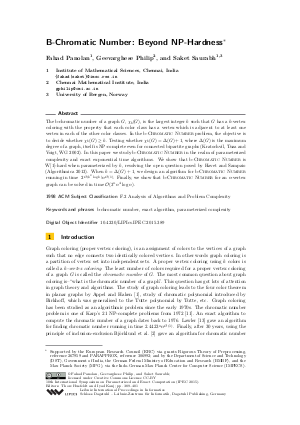B-Chromatic Number: Beyond NP-Hardness
Authors Fahad Panolan, Geevarghese Philip, Saket Saurabh
-
Part of:
Volume:
10th International Symposium on Parameterized and Exact Computation (IPEC 2015)
Part of: Series: Leibniz International Proceedings in Informatics (LIPIcs)
Part of: Conference: International Symposium on Parameterized and Exact Computation (IPEC) - License:
 Creative Commons Attribution 3.0 Unported license
Creative Commons Attribution 3.0 Unported license
- Publication Date: 2015-11-19
File

PDF
LIPIcs.IPEC.2015.389.pdf
- Filesize: 0.49 MB
- 13 pages
Document Identifiers
Subject Classification
Keywords
- b-chromatic number
- exact algorithm
- parameterized complexity
Metrics
- Access Statistics
-
Total Accesses (updated on a weekly basis)
0PDF Downloads0Metadata Views
Abstract
The b-chromatic number of a graph G, chi_b(G), is the largest integer k such that G has a k-vertex coloring with the property that each color class has a vertex which is adjacent to at least one vertex in each of the other color classes. In the B-Chromatic Number problem, the objective is to decide whether chi_b(G) >= k. Testing whether chi_b(G)=Delta(G)+1, where Delta(G) is the maximum degree of a graph, itself is NP-complete even for connected bipartite graphs (Kratochvil, Tuza and Voigt, WG 2002). In this paper we study B-Chromatic Number in the realm of parameterized complexity and exact exponential time algorithms. We show that B-Chromatic Number is W[1]-hard when parameterized by k, resolving the open question posed by Havet and Sampaio (Algorithmica 2013). When k=Delta(G)+1, we design an algorithm for B-Chromatic Number running in time 2^{O(k^2 * log(k))}*n^{O(1)}. Finally, we show that B-Chromatic Number for an n-vertex graph can be solved in time O(3^n * n^{4} * log(n)).
Cite As Get BibTex
Fahad Panolan, Geevarghese Philip, and Saket Saurabh. B-Chromatic Number: Beyond NP-Hardness. In 10th International Symposium on Parameterized and Exact Computation (IPEC 2015). Leibniz International Proceedings in Informatics (LIPIcs), Volume 43, pp. 389-401, Schloss Dagstuhl – Leibniz-Zentrum für Informatik (2015)
https://doi.org/10.4230/LIPIcs.IPEC.2015.389
BibTex
@InProceedings{panolan_et_al:LIPIcs.IPEC.2015.389,
author = {Panolan, Fahad and Philip, Geevarghese and Saurabh, Saket},
title = {{B-Chromatic Number: Beyond NP-Hardness}},
booktitle = {10th International Symposium on Parameterized and Exact Computation (IPEC 2015)},
pages = {389--401},
series = {Leibniz International Proceedings in Informatics (LIPIcs)},
ISBN = {978-3-939897-92-7},
ISSN = {1868-8969},
year = {2015},
volume = {43},
editor = {Husfeldt, Thore and Kanj, Iyad},
publisher = {Schloss Dagstuhl -- Leibniz-Zentrum f{\"u}r Informatik},
address = {Dagstuhl, Germany},
URL = {https://drops.dagstuhl.de/entities/document/10.4230/LIPIcs.IPEC.2015.389},
URN = {urn:nbn:de:0030-drops-55997},
doi = {10.4230/LIPIcs.IPEC.2015.389},
annote = {Keywords: b-chromatic number, exact algorithm, parameterized complexity}
}
Author Details
References
-
Kenneth Appel and Wolfgang Haken. The solution of the four-color-map problem. Sci Am, 237(4):108-121, October 1977.

-
Andreas Björklund, Thore Husfeldt, and Mikko Koivisto. Set partitioning via inclusion-exclusion. SIAM J. Computing, 39(2):546-563, 2009.

-
Manfred Cochefert. Algorithmes Exacts et Exponentiels pour les Problèmes NP-difficiles sur les Graphes et Hypergraphes. PhD thesis, Université de Lorraine, December 2014.

-
Marek Cygan, Fedor V. Fomin, Łukasz Kowalik, Daniel Lokshtanov, Dániel Marx, Marcin Pilipczuk, Michal Pilipczuk, and Saket Saurabh. Parameterized Algorithms. Springer, 2015.

-
Rodney G. Downey and Michael R. Fellows. Fundamentals of Parameterized Complexity. Texts in Computer Science. Springer, 2013.

-
Brice Effantin, Nicolas Gastineau, and Olivier Togni. A characterization of b-chromatic and partial grundy numbers by induced subgraphs. CoRR, abs/1505.07780, 2015.

-
Frantisek Galcík and Ján Katrenic. A note on approximating the b-chromatic number. Discrete Applied Mathematics, 161(7-8):1137-1140, 2013.

-
Frédéric Havet, Cláudia Linhares Sales, and Leonardo Sampaio. b-coloring of tight graphs. Discrete Applied Mathematics, 160(18):2709-2715, 2012.

-
Frédéric Havet and Leonardo Sampaio. On the grundy and b-chromatic numbers of a graph. Algorithmica, 65(4):885-899, 2013.

-
Robert W. Irving and David Manlove. The b-chromatic number of a graph. Discrete Applied Mathematics, 91(1-3):127-141, 1999.

-
Richard M. Karp. Reducibility among combinatorial problems. In Complexity of computer computations, pages 85-103. Plenum Press, New York, 1972.

-
Jan Kratochvíl, Zsolt Tuza, and Margit Voigt. On the b-chromatic number of graphs. In Ludek Kucera, editor, Graph-Theoretic Concepts in Computer Science, 28th International Workshop, WG 2002, Cesky Krumlov, Czech Republic, June 13-15, 2002, Revised Papers, volume 2573 of Lecture Notes in Computer Science, pages 310-320. Springer, 2002.

-
E. L. Lawler. A note on the complexity of the chromatic number problem. Information Processing Lett., 5(3):66-67, 1976.

-
Arnold Schönhage and Volker Strassen. Schnelle Multiplikation großer Zahlen. Computing, 7(3-4):281-292, 1971.

